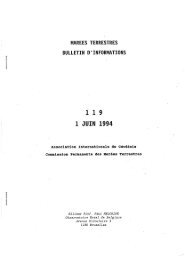marees terrestres bulletin d'informations - Université de la Polynésie ...
marees terrestres bulletin d'informations - Université de la Polynésie ...
marees terrestres bulletin d'informations - Université de la Polynésie ...
Create successful ePaper yourself
Turn your PDF publications into a flip-book with our unique Google optimized e-Paper software.
6. Application of <strong>la</strong>ser interferometric <strong>de</strong>vices to precise observation of Earth tidal<br />
<strong>de</strong>formations<br />
In or<strong>de</strong>r to observe crustal <strong>de</strong>formations, various types of extensometers (strainmeters) have been<br />
<strong>de</strong>veloped during the <strong>la</strong>st half of 20 th century (e.g. Sassa type and Ozawa type extensometers). These meters<br />
are essentially using solid materials of low thermal conductivity as a “length standard” for measuring a<br />
re<strong>la</strong>tive disp<strong>la</strong>cement between two piers fixed into the bedrock (see Figure 6). Super-Invar wires (rods) or<br />
fused quartz tubes are commonly used as the length standard.<br />
On the other hand, the appearance of the <strong>la</strong>ser at the beginnings of 1960s opened up new possibilities in<br />
crustal strain measurements. Using the coherent and stable <strong>la</strong>ser source, interferometric strainmeters have<br />
been <strong>de</strong>veloped (e.g. Berger and Lovberg (1969). The <strong>la</strong>ser interferometric strainmeter enables the small<br />
strain to be measured quantitatively in terms of the wavelength of the <strong>la</strong>ser light without using a length<br />
standard of any solid materials.<br />
In Kyoto University, the <strong>la</strong>ser interferometric <strong>de</strong>vice was used for calibrating conventional rod type<br />
extensometers at first. Then, <strong>la</strong>ser strainmeters of the Michelson type were installed at the Amagase Crustal<br />
Movement Observatory, Kyoto in 1977 (Takemoto, 1979). The same type <strong>la</strong>ser strainmeter was installed at<br />
the Rokko-Takao station in 1988 (Takemoto et al., 1998b). As mentioned before, precursory strain changes<br />
could not be <strong>de</strong>tected before the earthquake of January 17, 1995, but we could estimate the fluid core<br />
resonance using the data of the <strong>la</strong>ser strainmeter installed at the Rokko-Takao tunnel in Kobe (Mukai et al.,<br />
2004).<br />
On the other hand, a new technique based on holographic interferometry was <strong>de</strong>veloped for measuring<br />
crustal <strong>de</strong>formations (Takemoto, 1986, 1990). The holographic recording system, consisting of an He-Ne gas<br />
<strong>la</strong>ser and associated optical elements, was first installed in a tunnel at the Amagase Crustal Movement<br />
Observatory in 1984. Tunnel <strong>de</strong>formations caused by tidal and tectonic forces were precisely <strong>de</strong>termined<br />
using ‘real-time’ technique of holographic interferometry. In this procedure, a hologram of the tunnel wall<br />
within a section 1-2 m in diameter was directly recor<strong>de</strong>d on a photographic p<strong>la</strong>te and then the p<strong>la</strong>te was<br />
carefully reset in the same position at which the hologram had been taken. When the reconstructed image of<br />
the hologram was superimposed on the current image of the tunnel wall, many interferometric fringes could<br />
be seen through the hologram. The fringe disp<strong>la</strong>cement, formed by the <strong>de</strong>formation of the tunnel, was<br />
continuously recor<strong>de</strong>d on a vi<strong>de</strong>o cassette tape using a vi<strong>de</strong>o camera and a time-<strong>la</strong>pse vi<strong>de</strong>o recor<strong>de</strong>r. The<br />
change in the fringe patterns was analyzed using the image-processing system. Tidal <strong>de</strong>formations obtained<br />
from the holographic method were consistent with the strain changes observed with <strong>la</strong>ser strainmeters in the<br />
same tunnel. These observational results substantiated the tunnel <strong>de</strong>formation estimated by the finite-element<br />
calcu<strong>la</strong>tions.<br />
The holographic system, however, has a margin for improvement in use of the long-term strain<br />
measurements because the fringe pattern observed through the photographic p<strong>la</strong>te gradually blurs over the<br />
course of the time. Thus, a clear record of holographic interferometry cannot be obtained even over a week.<br />
Therefore, we attempted to use the Electronic Speckle Pattern Interferometry (ESPI) technique, in which the<br />
interference fringe pattern can be produced without using photographic processing but instead using<br />
electronic processing (Takemoto et al., 1998a). This attempt, however, did not succeed due to technical<br />
difficulty in <strong>de</strong>tecting slowly moving crustal <strong>de</strong>formation.<br />
In 2002, we installed a 100m <strong>la</strong>ser strainmeter system in a <strong>de</strong>ep tunnel about 1,000m below the ground<br />
surface at the Kamioka mine, Gifu, Japan (Figure 9). As shown in Figure 10, the system consists of three<br />
types of in<strong>de</strong>pen<strong>de</strong>nt interferometers: (1) an EW linear strainmeter of the Michelson type with unequal arms,<br />
(2) an NS-EW differential strainmeter of the Michelson type with equal arms and (3) a NS absolute<br />
strainmeter of the Fabry-Perot type. These are configured in L-shaped vacuum pipes, each of which has a<br />
length of 100 m. (1) and (2) are highly sensitive (or<strong>de</strong>r of 10 −13 strain) and have wi<strong>de</strong> dynamical range (10 −13<br />
-10 −6 ). (3) is a new <strong>de</strong>vice for absolute-length measurements of a long-baseline (100 m) Fabry-Perot cavity<br />
with a precision of the or<strong>de</strong>r of 10 −9 by the use of phase-modu<strong>la</strong>ted light (Takemoto et al., 2004, 2006). The<br />
11774



